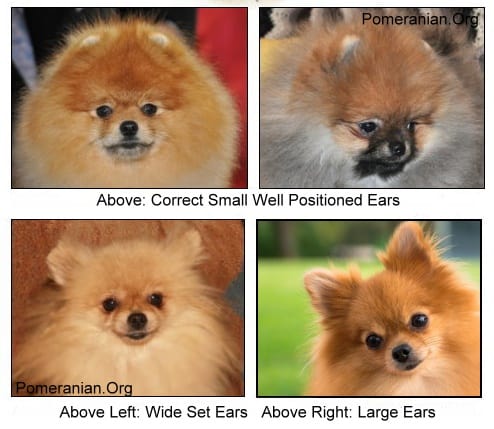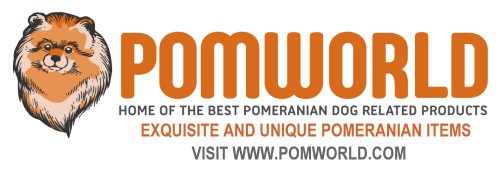Last Updated on 07/09/2023 by Dochlaggie. Post first published on June 22, 2020.
There’s a lot to know when it comes to Pomeranian ears, so I’ll break it down into these aspects:
- Pomeranian ear size and set.
- How a Pomeranian’s ears change as he matures.
- Pomeranian ears floppy.
- Different problems.
- Specifics regarding ear infections.
- How to clean Pomeranian ears and care tips all owners MUST know.
Pomeranian ears are erect, triangle-shaped, pointed and small. Under the AKC standard, they should be “small, mounted high and carried erect. Proper ear set should be favored over size.” In other words, position is first and then size is analyzed as the second factor.
Generally speaking ears on show Poms are quite small, while the ears on pet Poms will vary from the tiny ears on show dogs, up to the big ears that slightly resemble fox ears.

The ears of a Pom usually have a cover of short hair. Show Pomeranians will have the hair on the tips of the ears trimmed to show the judge how big the actual ear is. If a Pom’s ears are set properly, he has an intelligent, alert facial expression that makes him highly valued.
Genes will determine how big a Pomeranian’s ears will be. To determine a Pom’s ear size, it’s best to look at the ears of both the sire and dam.
The FCI requirement is that Pomeranian ears should have a similarity to the expectations of the AKC breed standard. However, there will be a lot more detail in the vernacular.
“The small ears are set high and relatively close to each other, triangular and pointed; they are always carried upright, stiff at the tips.”
Why Are Pomeranian Ears Small?
The breed standard states that Pomeranians should have small ears because they originated from certain regions of the Northern Hemisphere where temperatures in that area may drop as low as minus 30 degrees in Winter.
Small ears enable Poms to survive in the frozen cold habitats where they require a low ratio of volume to surface area. Pomeranian ancestors fought to conserve every possible bit of heat while fighting the harshest Arctic winter months. A Pomeranian with big ears would suffer frostbite in these conditions.
Changes in Pomeranian Ear Size and Shape from Puppy to Adulthood
All Pomeranians have unique ears that range from small to medium to large. As he grows, his ears will also grow.
The ears of Pom puppies are often incredibly small when compared to his face overall. A Pomeranian’s genes may dictate that his ears will be big. Regardless of the size of an adult’s ears, they should stand erect and be a triangle shape.
Puppy Ears That Won’t Stand Erect
The Pomeranian dog breed is so well-known for having erect ears that it’s a rarity if you find a Pomeranian with ears that are actually floppy. Most Pomeranian ears stand up, however, it does occasionally occur.
Sad to say, the majority of cases of a Pomeranian with floppy ears are a result of bad breeding practices, meaning the ears won’t become erect over time.
During a Pom’s teething period (4-5 months to 8-9 months approximately), ears can be affected. This is usually the result of a lack of calcium in the diet. They might flop a bit or stand erect at different times.
In such scenarios, it’s common for the muscles to become stronger and this means that by the time they are 12 months old, their ears will be permanently erect.
Floppy Pomeranian ears can be caused by excess, heavy hair growing on the actual ear itself. If it’s too heavy, the ear will flop down. Other causes are poor breeding and genetics.
Pomeranian Matted Hair Behind Ears
The hair behind a Pomeranian’s ears has a tendency to clump into mats if regular correct care isn’t given to this area.
Brush the area often and rub in talcum powder which will absorb any oiliness, prevent matting and separate each hair.
If you don’t keep on top of grooming this area, you’ll have to deal with matted hair.
Cutting Out Mats
If your Pomeranian’s coat has a mat only connected by a couple of hairs, it’s easy to cut it out. If there’s a large mat secured by lots of hair and it’s close to your dog’s skin, it’s possible you’ll cut his skin while attempting to cut that mat.
You can also try cutting the mat into several smaller mats and then work on each of those small mats. When cutting out a mat, always cut down into a mat; never cut across a mat.
Pomeranian Ear Problems
Parasites
Ear Mites
Ear mites are one of the major ear infestations, are extremely contagious, usually spreading to all dogs within the home quickly. These nasty, crab-like parasites are tiny and enter dogs through their ear passages.
These mites live on the ear canal’s skin surface, feeding on fluids and debris of the dog’s tissues, and may also attack skin on the rest of his body.
You’ll know when this occurs because your dog will endure intense itchy feelings on his tail, neck and back. Ear mites can strike canines of all ages but are most prevalent in puppies.
As with most canine ear troubles, you’ll know if our dog is suffering as he will be attempting to scratch his ears and shake his head in desperation. If you check in his ears, you’ll often see a dark mass that looks like ground coffee.
- Tomlyn Earoxide for Dogs and Cats 4oz

- Price: $9.99
- Bio-Groom Ear Mite Treatment, 4 oz

- Price: $11.99
The ideal treatment for ear mites is to use a liquid ear solution with a pyrethrin base, as this destroys mites and ticks. It’s usually used 2 to 3 times each day for 10 days. You put several drops into his ears and then massage the base.
If it’s mites, it’s imperative that you wash everything including sheets, bedding, his toys and everything else he may have touched. All other dogs and cats must also get treated to prevent the spread of this highly contagious mite.
Mange
Mange (parasitic mites cause this skin disease)lives on almost every dog of every breed and is found in hair follicles. A dam will give all her puppies this disease within the first two weeks of their lives.
Mange mainly causes trouble for new puppies before their immune systems have completely developed, and in senior dogs due to their weakened immune systems.
Indicators that your puppy or dog has mange include: hair loss, visible crusting, and intense itching (pawing, rubbing and/or shaking his head).
This disease generally appears on a dog’s face and, sometimes, it may focus on the ears, but it may also spread around his entire body.
If puppies have mange in one area, it could heal without treatment because they get older and immune systems grow stronger. For adults, on the other hand, the vet needs to treat him as it requires strong dips and scabicidal shampoos.
Scabies
Scabiesis the result of a highly contagious skin parasite known as the Sarcoptes Scabiei mite. This nasty infection not only gets spread between canines but also felines and, in some cases, human beings.
The main indicator of scabies is chronic itching, causing incredible discomfort, depending on the location(s). It’s most commonly found on the chin, ear flaps, abdomen, chest, hocks and elbows.

There are a few other symptoms such as: hair loss, crusty sores and secondary infections on the skin.
It’s critical that the affected animal(s) are isolated from all other household members including dogs, cats and humans, until every creature is back to good health again.
Your vet will advise you of the best way to treat scabies. You’ll need certain dips and shampoos. You may also require medicated treatment sprays to treat your whole home.
Items you must wash include: bedding, sheets, towels, clothing and anything else that you’re able to place in a machine. Make sure you use hot water.
Fleas
Fleas can live anywhere on the body of a canine but strongly prefers the dark moist area inside the ears where itchy feelings will be worse than anywhere else.
Owners need to take care in applying any sort of flea and tick preventative unless necessary. I find the cat variety is probably the safest option for these tiny dogs.
- SDISC K9 Advantage II for Small Dogs 4 pack

- Price: $56.99
- Vets Best Flea and Tick Waterless Bath for Cats 5oz

- Price: $10.28
Pomeranian Ear Infections
The majority of dogs will experience at least one infection in their ears during their life.
It’s one of the leading reasons for taking your trusty Pom to see the vet. Lots of dogs face chronic health challenges throughout their lives.
Bacteria is the main cause of infections, but yeast is a cause from time to time.
I’ll examine these issues in greater detail below:
Overview: Ear infections can happen in the inner ear (aka otitis interna) or the middle ear (aka otitis media) and sometimes they’re incredibly painful.
Causal types: The main cause of canine ear infections is bacteria. However, sometimes the cause can be yeast or fungi.
Causes: The two main elements that can create an ear infection are: Too much wax, and an excessive amount of cleaning by the owner.
Too much moisture in his ears is a cause that’s easily avoided by putting cotton wool in your dog’s ears before bathing him.
Other causes include viruses, allergies, thyroid disorders, reactions to medications, endocrine disorders, autoimmune diseases and even foreign bodies such as small bits of grass, etc., in his ears.
Symptoms: There are lots of symptoms of ear infections including the top one:
Intense itchiness. Your dog will try to stop it by rubbing the itchy spots against suitable surfaces, pawing at his ears and shaking his head.
Others include:
- An unpleasant odor.
- Discharge.
- The inner ear flap has swelling, redness and scaly skin.
- Reluctance to chew.
- Pain when he opens his mouth.
- Tilting his head.
- Leaning to his side where the ear is affected.
If he has an infection in both ears, he may also have some loss of hearing, a wobbly gait and/or moving his head in wide swinging movements.
If you even think your Pom has some sort of infection in one or both ears, it’s critical to get a proper diagnosis by your vet as quickly as you can, because it may spread from his middle ear to inner ear or from one to the other.
Diagnosis: There are a lot of ear infection types so, before the vet can accurately diagnose your dog, he’ll need to conduct quite a few tests such as:
- A visual assessment.
- An assessment of the pain level by softly palpating the ear.
- Using an otoscope to see deep inside the ear canal.
- A microscopic analysis of different samples of the dog’s tissues.
If an infection is either chronic or severe, your vet may request an MRI and/or x-rays be carried out to provide extra information.
Treatment: Because ear infections tend to be stubborn and powerful, the typical treatment is prescribed antibiotics of the aggressive nature.
The vet may prescribe:
- A topical antibiotic such as Panalog, Tresaderm, Otomax or Mometamx.
- And an oral antibiotic might be Orbiflaxcin, Enroflaxin or Cephalexin.
- If yeast is the cause, an antifungal treatment such as ketoconazole may be prescribed.
If a Pomeranian of any age seems to be suffering from severe pain (this frequently occurs), the vet will use steroids and the bonus is that itchiness will be reduced as well.
While at the clinic, the vet will flush out and then clean a Pom’s ears, while you watch because you’ll need to do the same routine when you take your dog home (more information on this ahead), generally once a complete course of topical medication has been used.
You’ll be asked to take your dog back to the vet for a checkup a week later. Your dog’s infection may take 10 to 30 days to clear up.
If your Pom is highly susceptible to ear infections, it’s critical that you do everything possible to care for him.
Pomeranian Ear Care
There are three major elements to consider when caring for his ears:
- Inspect them regularly.
- Keep them clean.
- Stop moisture from getting into his ear canal.
Baths: If your dog has moisture in his ears, it creates the ideal breeding ground - wet, dark and warm - for bacteria and yeast to exist.
To help stop this happening, put loose cotton pieces in your Pomeranian’s outer ear canal prior to bathing him.
You don’t have to push it deep down. The goal is to create a barrier that can assist with blocking water, soap, conditioner, shampoo and anything else from getting in.
How to clean Pomeranian ears: As with humans, anything smaller than an elbow should not be inserted into your dog’s ear canal.
I regularly clean the inside of my Pomeranian's ear leather by wiping clean with a warm, damp face washer.
Please do not go poking anything into the actual ear canal like a cotton bud etc.
If you observe any of the above symptoms of ear problems, please contact your vet.
Dealing With Pomeranian Ear Problems
Your Pomeranian’s ears must be looked after regularly. Every week you should follow a checklist so you don’t forget anything. Tasks on the list should include:
- Checking to ensure there is no wax, dirt or gunk in there.
- There should not be a smelly odor. They should smell good.
- If there’s gunk or redness in his ears, or if he’s always scratching, it’s time to ring your vet!
It is not hard to heal canine infections with medication. However, if your Pomeranian doesn’t get treated, he can suffer and potentially lose his hearing.
Please note: while I do discuss health, care, and behavioral issues, you should never use this information as a replacement for advice from qualified veterinarians, diagnoses, or recommended treatment regimes. If you have any worries about the health of your Pomeranian, your first contact should be your regular vet or, if you don’t yet have one, a vet that works locally. Never ignore or avoid treatment and advice from your vet because of a piece of information you have read on any website.
Copyright Pomeranian.org. All Rights Reserved.
References and Further Reading:
[1] Official Standard of the Pomeranian (AKC). American Kennel Club, 2011.
[2] English Kennel Club Pomeranian Breed Standard, 2017.
[3] Denise Leo, The Pomeranian Handbook.
[4] Milo G. Denlinger "The Complete Pomeranian."
[5] Kimbering Pomeranians "1891-1991".
[6] William Taplin's "The Sportsman’s Cabinet."
[7] E. Parker "The Popular Pomeranian."
[8] Lilla Ives "Show Pomeranians."









